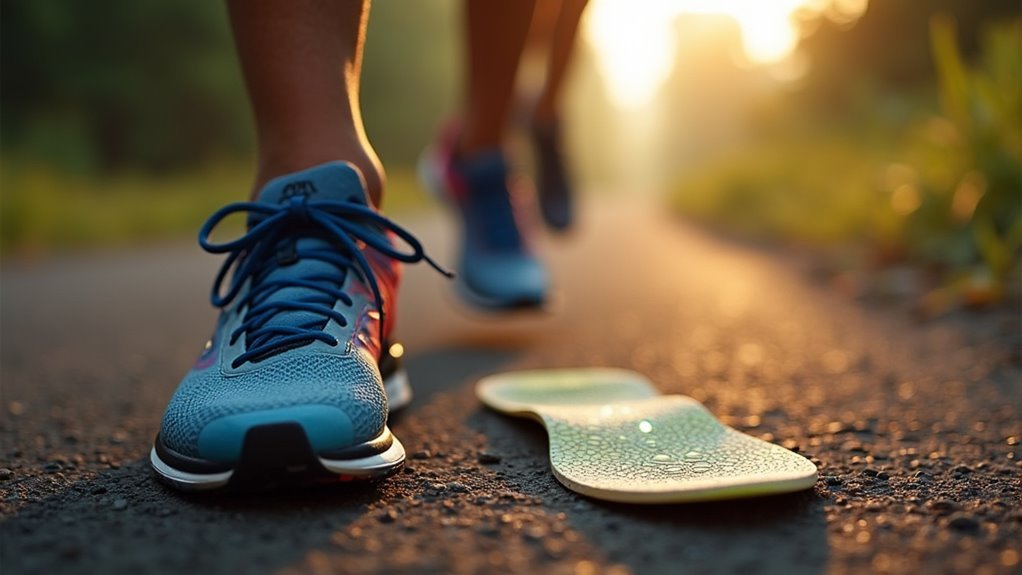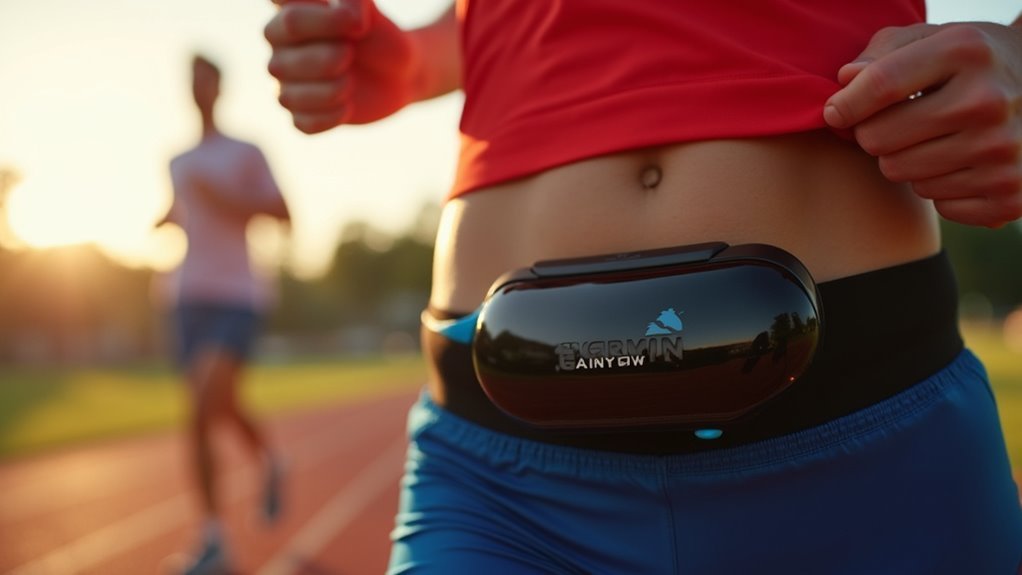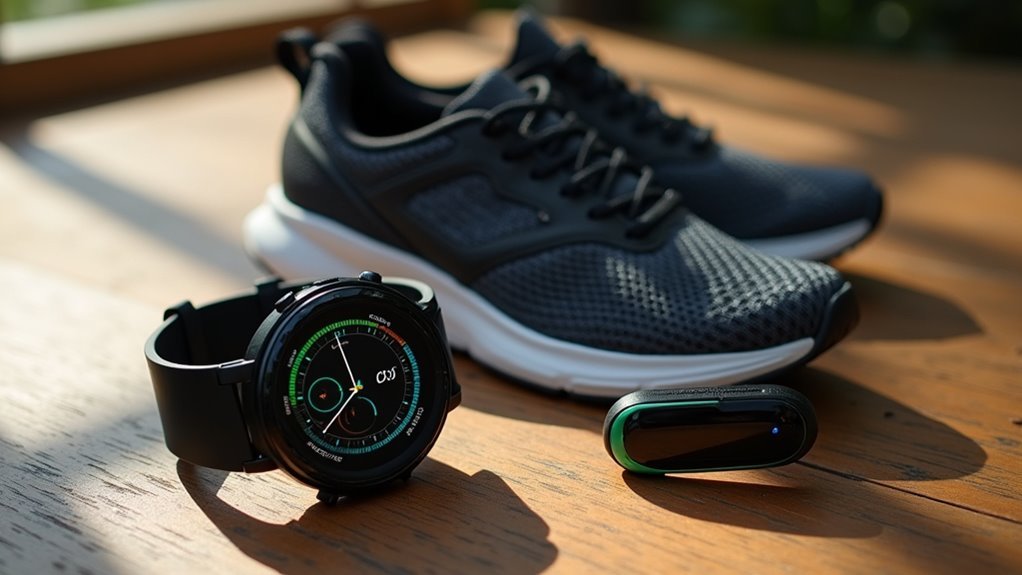You can greatly improve your running economy with three specialized wearables that capture critical biomechanical data. The ARION insole provides detailed ground contact analysis and real-time feedback on your running mechanics with under 10% error rates. Stryd’s footpod delivers precise power output measurements in watts along with cadence and ground contact time via Bluetooth. Garmin’s Running Dynamics Pod tracks six thorough form metrics including stride length and vertical oscillation from your waistband, enabling data-driven performance optimization through targeted technique adjustments.
ARION Insole for Ground Contact Analysis

When you’re looking to optimize your running performance through ground contact analysis, ARION Smart Insoles offer a sophisticated yet user-friendly solution that seamlessly integrates into your training routine.
These lightweight, non-intrusive insoles continuously capture biomechanical data including pressure points and motion patterns while you run. You’ll receive real-time feedback on your running mechanics, allowing immediate adjustments to improve your running economy.
Real-time biomechanical feedback helps runners make immediate adjustments to their form, optimizing running economy through continuous data capture.
The insoles demonstrate excellent accuracy in measuring spatiotemporal metrics, with individual errors typically under 10%. They quantify stride time, step frequency, contact time, and swing time with minimal mean differences compared to gold-standard measurements. With up to 5-6 hours of continuous data collection capability, these insoles can monitor your biomechanics throughout extended training sessions or races.
Unlike other wearables that focus on general activity tracking, ARION’s specialized ground contact analysis provides detailed insights into your foot-ground interaction patterns, helping you identify inefficiencies and prevent injuries through biomechanical optimization.
Stryd Footpod for Power and Distance Precision
Power-based training represents a paradigm shift in running performance optimization, and the Stryd Footpod delivers this capability through precise biomechanical measurement technology.
You’ll receive real-time power output in watts, measuring the actual biomechanical work you’re performing during each stride. The device’s triaxial accelerometer, gyroscope, and barometer capture extensive running metrics including form power, cadence, ground contact time, and vertical oscillation.
You can optimize your running economy by monitoring these metrics, as Stryd power correlates with oxygen cost at threshold paces. The footpod transmits data via Bluetooth, giving you immediate intensity feedback to adjust your technique and training zones. The power calculations incorporate real-time air resistance by analyzing local environmental conditions and your body morphology to provide comprehensive performance data.
While it’s effective for daily training optimization, you should note that accuracy limitations exist when discriminating between elite performance levels.
Garmin Running Dynamics Pod for Comprehensive Form Metrics

Biomechanical precision takes center stage with the Garmin Running Dynamics Pod, which delivers extensive form analysis through six distinct running metrics captured from your waistband.
This lightweight device weighs less than 0.5 ounces and clips easily onto your waistband, measuring cadence, stride length, ground contact time, vertical oscillation, balance metrics, and vertical ratio insights.
You’ll receive thorough feedback through automatic syncing with your compatible Garmin device and the Garmin Connect app. The pod utilizes ANT+ wireless technology operating at 2.4 GHz frequency for seamless data transmission.
The pod operates reliably in temperatures from -10°C to 50°C, turning on and off automatically to preserve its user-replaceable CR1632 battery that lasts approximately one year with daily hour-long sessions.
This data-driven approach enables you to evaluate running form, optimize stride mechanics, and make targeted training improvements for enhanced performance.
Frequently Asked Questions
How Do Running Economy Wearables Compare in Battery Life and Charging Requirements?
You’ll find Garmin Enduro 3 leads with 120 GPS hours, while COROS VERTIX 2S offers 118 hours. Most use USB-C charging, but Garmin’s solar models extend life considerably. You’ll get 7-40 days smartwatch mode depending on your choice.
What Is the Typical Price Range for Quality Running Economy Measurement Devices?
You’ll find basic GPS watches cost $100-$300, while advanced models with VO2 estimation run $300-$600. Specialized VO2 analyzers range $500-$2,000, and high-end devices with biomechanics feedback cost $1,000-$3,000.
Can Wearables Accurately Measure Running Economy in Different Weather Conditions?
You’ll find wearables generally maintain accurate running economy measurements across weather conditions, though extreme temperatures or humidity might slightly affect sensor readings. Most quality devices are designed to handle typical outdoor running environments reliably.
Do Running Economy Wearables Work Effectively for Trail Running Versus Road Running?
You’ll find limited research comparing trail versus road effectiveness, but wearables generally show minimal running economy improvement for both. Trail running’s uneven terrain may reduce accuracy compared to road running’s consistent conditions.
How Long Does It Take to See Meaningful Improvements Using Wearable Data?
You’ll start seeing meaningful improvements within 4-6 weeks of consistent use. Real-time feedback creates immediate technique adjustments, while chronic adaptations in VO2 and energy expenditure typically emerge over several months.
In Summary
You’ve got three solid options to dial in your running economy. The ARION insole gives you ground contact insights, Stryd delivers precise power metrics, and Garmin’s pod covers thorough form analysis. Each device targets different aspects of your efficiency, so pick based on what you’re looking to improve most. Don’t overthink it—start measuring, analyze your data consistently, and you’ll see meaningful improvements in your running performance.





Leave a Reply